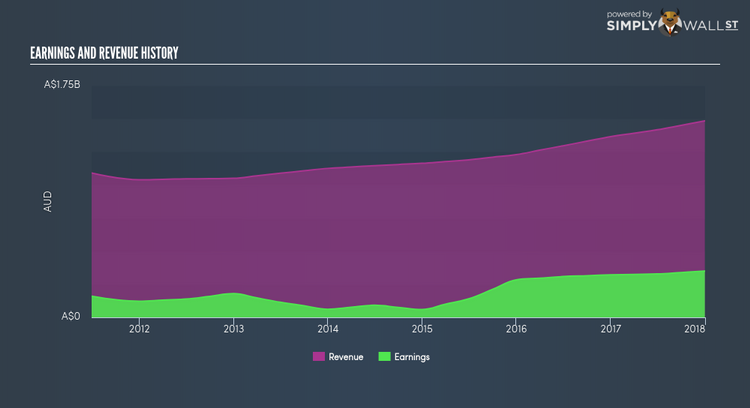With 9.01% Earnings Growth, Did Sydney Airport Limited (ASX:SYD) Outperform The Industry?

Assessing Sydney Airport Limited’s (ASX:SYD) past track record of performance is a useful exercise for investors. It allows us to understand whether the company has met or exceed expectations, which is a great indicator for future performance. Below, I assess SYD’s latest performance announced on 31 December 2017 and evaluate these figures to its historical trend and industry movements. See our latest analysis for Sydney Airport
How Did SYD’s Recent Performance Stack Up Against Its Past?
I look at data from the most recent 12 months, which annualizes the latest 6-month earnings release, or some times, the latest annual report is already the most recent financial data. This blend enables me to analyze various companies on a more comparable basis, using new information. For Sydney Airport, its most recent bottom-line (trailing twelve month) is AU$349.80M, which compared to the previous year’s level, has increased by a somewhat soft 9.01%. Since these values may be relatively short-term thinking, I’ve calculated an annualized five-year figure for Sydney Airport’s earnings, which stands at AU$189.04M This means that, on average, Sydney Airport has been able to consistently raise its earnings over the last few years as well.
What’s enabled this growth? Let’s see whether it is merely owing to an industry uplift, or if Sydney Airport has seen some company-specific growth. Over the last couple of years, Sydney Airport expanded its bottom line faster than revenue by effectively controlling its costs. This has caused a margin expansion and profitability over time. Eyeballing growth from a sector-level, the Australian infrastructure industry has been growing average earnings growth of 77.30% in the previous twelve months, and a strong 13.99% over the previous five years. This shows that whatever uplift the industry is deriving benefit from, Sydney Airport has not been able to realize the gains unlike its industry peers.
What does this mean?
Though Sydney Airport’s past data is helpful, it is only one aspect of my investment thesis. Positive growth and profitability are what investors like to see in a company’s track record, but how do we properly assess sustainability? You should continue to research Sydney Airport to get a more holistic view of the stock by looking at:
Future Outlook: What are well-informed industry analysts predicting for SYD’s future growth? Take a look at our free research report of analyst consensus for SYD’s outlook.
Financial Health: Is SYD’s operations financially sustainable? Balance sheets can be hard to analyze, which is why we’ve done it for you. Check out our financial health checks here.
Other High-Performing Stocks: Are there other stocks that provide better prospects with proven track records? Explore our free list of these great stocks here.
NB: Figures in this article are calculated using data from the trailing twelve months from 31 December 2017. This may not be consistent with full year annual report figures.
To help readers see pass the short term volatility of the financial market, we aim to bring you a long-term focused research analysis purely driven by fundamental data. Note that our analysis does not factor in the latest price sensitive company announcements.
The author is an independent contributor and at the time of publication had no position in the stocks mentioned.

 Yahoo Finance
Yahoo Finance 
